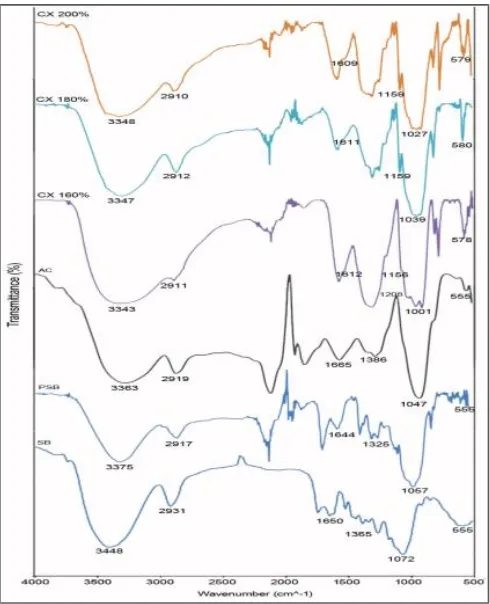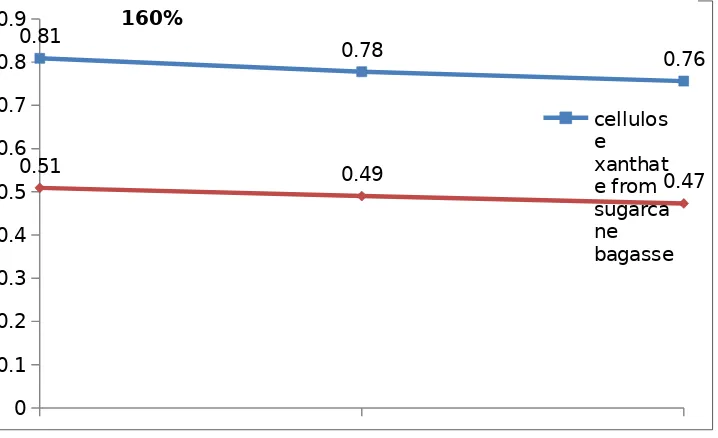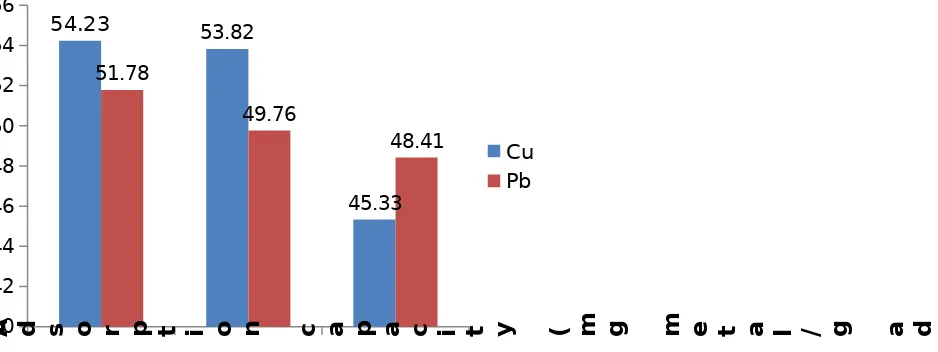Preparation and Evaluation Adsorption Capacity of
Cellulose Xanthate of Sugarcane Bagasse for Removal
Heavy Metal Ion from Aqueous Solutions
D. A. Iryani
1,4,*, N. M. Risthy.
1, D.A. Resagian
1, S. D.Yuwono
2,4, U. Hasanudin
3,41Department of Chemical Engineering, Engineering Faculty, University of Lampung 2Department of Chemistry, Mathemathic and Science Faculty, University of Lampung 3Department of Agroindustrial Technology, Agriculture Faculty, University of Lampung 4Research and Development Center for Tropical Biomass, University of Lampung
Abstract. The discharge of heavy metals from industrial effluents into aquatic system in surrounding area of Lampung bay become a serious problem today. The data shows that the concentrations of heavy metals in this area are above allowable limits for the discharge of toxic heavy metals in the aquatic systems. The most common of heavy metal pollutant is divalent metal ions. Cellulose xanthate is one of the selective adsorbent to solve this problem, since xanthate contains two negative sulfur atoms that is capable to catch divalent metal ions. Preparation of cellulose xanthate was conducted by reacting carbon disulfide (CS2) and cellulose from sugarcane bagasse. The morphological characteristics of cellulose xanthate were visualized via Scanning Electron Microscope (SEM) and the presence of sulfur groups on sugarcane bagasse xanthate were identified by FTIR spectroscopic study. The degree of substitution (DS), degree of polymerization (DP), and adsorption capacities of cellulose xanthate for Cu2+ and Pb2+ metal were studied. The results of study reveals that the maximum adsorption capacities of Cu2+ and Pb2+ metal on cellulose xanthate are 54.226 mg Cu2+/g, and 51.776 mg Pb2+/g, respectively. This study reveals that cellulose xanthate could be a solution to reduce environmental pollution caused by industrial wastewater.
Keywords:Sugarcane bagasse, cellulose xanthate, adsorbent, heavy metal.
1. Introduction
health problems such as brain damage, metabolic disorders, and death. Toxicity in small doses can cause neurotoxic (neurotoxin) and abnormal behavior (Darmono, 1995).
There are many methods for removal of heavy metals ion from aqueous solutions. The most simple and effective technique for removal of heavy metals ion from aqueous solutions is adsorption process, and ion-exchange are very often used in adsorption processes (Wang and Peng, 2010). Nowadays, there has been considerable interest in the use of agricultural by-products as an adsorbents to solve this problem due to have some advantages include relative cheapness, renewability, high adsorption capacity, and abundance in nature especially in Lampung Province. Lampung is one of the provinces with abundant sugarcane bagasse resources (Silviani, 2014). Sugarcane bagasse is the by-product of sugar industry, which is constituted of cellulose, lignin and hemicellulose. Since sugarcane bagasse contains a large amount of hydroxyl groups in the structure (Iryani et al, 2014), its absorption capability can be improved by chemical modification (Vaughan et al, 2001).
The purpose of this study was to modify sugarcane bagasse with carbon disulfide (CS2) to enhance its adsorption properties for the removal of Cu2+ and Pb2+ from aqueous solutions. Sugarcane bagasse can uses as an adsorbent of heavy metal waste by converting it to cellulose xanthate. Cellulose xanthate is a reaction product of cellulose with carbon disulfide (CS2) that forms a salt with the chemical formula ROCS2-M+ (R = alkyl; M+ = Na+) (Heuser E, 1943). Basically, xanthate contains two negative sulfur atom that is capable to catch divalent metal ions such as Cu2+, Pb2+, and others (Riwayati et al, 2014). Effect of concentrations of CS2 in cellulose xanthate synthesis was studied. The morphological characteristics of cellulose xanthate were visualized via Scanning Electron Microscope (SEM) and the functional groups present in the adsorbent were characterized by a Fourier Transform Infrared (FTIR) spectrophotometer. The degree of substitution (DS), degree of polymerization (DP), and adsorption capacities of cellulose xanthate (CX) for Cu2+ and Pb2+ metal were also studied.
2. Materials and Methods 2.1 Chemicals
All chemicals Purchased from Merck were NaOH, carbon disulfide (CS2), HNO3, H2SO4, BaCl2, distilled water and heavy metal solutions PbSO4 and CuSO4.
2.2 Sugarcane Bagasse Purification
About 15 g of PSB was soaked in 100 mL of 18% NaOH solution and stirred for 3 hours at room temperature (Gilbert R, 1994). About 160, 180, 200% of CS2 (w/w) by the amount of cellulose used was added to the mixture. It means about 24 g (19.2 mL) of CS2 was used on the CS2 concentration of 160%, 27 g (21.6 mL) of CS2 on the CS2 concentration of 180%, and 30 g (24 mL) of CS2 on the CS2 concentration of 200%. After CS2 was added to the mixture, the reaction was continued for 100 minutes at 35°C (Heuser E, 1943). The product of cellulose xanthate (CX) was washed with distilled water to remove excess alkali, and then the sample was dried at 105°C for 3 hours and stored at low temperature (5-8°C) (Tian et al, 2015).
2.4. Biosorption Experiments And Analysis
All of the adsorption tests carried out by the batch technique. About 0.1 g of adsorbent was put into a 100 mL conical flask together with a 100 mL single metal ion (Cu2+ or Pb2+) solution with pH range 2.0-6.5. The concentration of metal ion solution was 100 mg/L. The mixture was shaken at 120 rpm on a shaker for 2 hours (Tian et al, 2015). The residual metal ion concentrations in the supernatant liquor were determined by using an Atomic Absorption Spectrophotometer (AAS), the amount of metal adsorbed (Q) were determined by using the following equations:
Q =
V (Co-Ca)
m
(1)Where Co (mg/L) and Ca (mg/L) are the initial and final metal ions concentrations, respectively. V (L) is the volume of solution, and m (g) is the weight of cellulose xanthate (adsorbent) (Tian et al, 2015).
2.5. Determination of degree of substitution (DS)
The degree of substitution is the ratio between the number of xanthate groups per cellulose unit in the cellulose xanthate compound. Before calculating the value of DS, the ratio of sulfur to cellulose ((% sulfur)/(% cellulose)) has to be determined first. Amount of sulfur in the cellulose xanthate was determined by using gravimetric methods (SNI 06-6989.20-2004), whereas amount of cellulose in the cellulose xanthate was determined by using gravimetric methods (Sluiter et al, 2005). The ratio of sulfur to the cellulose of 0.395, stating there is one xanthate group per cellulose unit in the cellulose xanthate.
Thus, the value of DS can be determined by using the following equation (Vincent D, 1953):
DS =
ratio of sulfur to glucose
0.395
(3)2.6. Determination of degree of polymerization (DP)
DP =
Molecular weight of CX
Molecular weight of structural unit
(4)The molecular weight of cellulose xanthate can be determined with the viscosity methods by using Viscometer Ostwald. This methods has been conducted by (Agnemo, 2009). Molecular weight of cellulose xanthate was calculated by using Mark Houwink equations:
[ƞ] = K.Ma
[ƞ] = viscosity of cellulose xanthate
M = Molecular weight of cellulose xanthate.
K and a are the constants of Mark-Houwink, K = 12 x 10-3 mL/g and a = 0,52.
3. Results and Discussion
3.1. Characterization of the Adsorbent
Cellulose xanthate was synthesized by reacting cellulose with an amount of carbon disulfide (CS2) in NaOH solution. In this study, cellulose xanthate was synthesized by reacting purified sugarcane bagasse (PSB) with 160, 180, and 200% of CS2 (w/w, by the amount of PSB used) in NaOH solution (18%). Figure 1 shows the hydroxyl groups on the cellulose backbone combined with CS2 in the xanthation process.
Figure 1. Scheme of cellulose xanthate synthesis (Homagai et al, 2010)
that is attributed to the presents of Na. There are new peaks around 580 cm-1, 1030 cm-1, and 1156 cm-1 at FTIR spectrum of CX 160%, CX 180%, and CX 200%, that correspond to C-S, C=S, and S-C-S, respectively, which indicates the existence of sulfur groups in cellulose xanthate (CX). Compared to the spectrum of SB and PSB, there are some different functional groups in the spectrum of CX. The strong O-H band at 3,448 cm-1 in the spectrum of SB is shifted to 3,343 cm-1, 3,347 cm-1, and 3,348 cm-1 in the spectrum of CX 160%, CX 180%, and CX 200%, respectively, which shows that the hydroxyl groups have combined with CS2 in the xanthation process.
Figure 2. FTIR spectra of SB, PSB, AC, and CX
Figure 3. SEM of PSB Figure 4. SEM of CX
The degree of substitution (DS) and degree of polymerization (DP) of cellulose xanthate (CX) were also carried out as a quantitative analysis. DS represents the number of xanthate groups per cellulose unit in the CX compound, whereas DP represents the amount of structural unit in the CX.
0 0.1 0.2 0.3 0.4 0.5 0.6 0.7 0.8 0.9
0.81
0.78 0.76
0.51 0.49
0.47 cellulos e xanthat e from sugarca ne bagasse
Figure 5. DS of cellulose xanthate
Figure 5 and Figure 6 shows the effects of CS2 content used in CX synthesis to the value of DS and DP. The CX made with 160% of CS2 showed higher value of DS and DP. The highest value of DS are 0.809 for CX from sugarcane baggase and 0.509 for CX from commercial cellulose, whereas the higher value of DP is 325.757. If CS2 content was higher than 160%, the value DS and DP was
be adsorbed physically on the hydrocarbon backbone if using an excess amount of CS2 in CX
Figure 6. DP of cellulose xanthate
3.2. Adsorption Capacity
There are some important parameters affecting the adsorption process such as pH, temperature, etc. According to the (Tian et al., 2015), pH range of aqueous solution are from 2.0 to 6.5 on adsorption of Cu2+ and Pb2+ at room temperature for 120 min. 0.1 g of adsorbent was taken into a 100 mL conical flask together with a 100 mL single metal ion (Cu2+ or Pb2+) solution. The concentration of metal ion solution was 100 mg/L. The mixture was shaken at 120 rpm on a shaker for 2 hours. The residual metal ion concentrations in the supernatant liquor were determined by using an Atomic Absorption Spectrophotometer (AAS). Adsorption capacities of cellulose xanthate for Cu2+ and Pb2+ metal are shown in Figure 7.
Figure 7. Adsorption capacity of cellulose xanthate
Adsorption capacity of cellulose xanthate decreases when CS2 content in xanthation process was higher. This trend is similar to the trend of DS and DP of cellulose xanthate. Cellulose xanthate made with 160% of CS2 showed higher adsorption capacities of Cu2+ and Pb2+ metal, that are 54.226 mg/g
A
d
s
o
r
p
t
i
o
n
c
a
p
a
c
i
t
y
(
m
g
m
e
t
a
l
/
g
a
d
s
o
r
b
e
n
)
and 51.776 mg/g, respectively. This trend was also observed in experiments of (Kim and Lee, 1999) with Pb2+ under pH 6.5. According to the experiments of (Kim and Lee, 1999), by using more than 14 mL of CS2 in the cellulose xanthate synthesis, lead removal was decreased. It reveals that an excess amount of CS2 in the cellulose xanthate synthesis decreases the value of DS, DP, and adsorption capacity.
4. Conclusions
Cellulose xanthate was synthesized by reacting cellulose of sugarcane bagasse with an amount of carbon disulfide (CS2) then to be used as an adsorbent for the removal Cu2+ and Pb2+ from aqueous solution. FTIR spectra showed the presence of the sulfur groups in the cellulose xanthate. The SEM were carried out to describe the morphological characteristics of adsorbent. The morphological of cellulose xanthate indicated the finer, expands, and uniform pattern of cellulose structure, which could increase the porosity, specific surface area, and improve the adsorption capacity of adsorbent for heavy metal ions in aqueous solution. The degree of substitution (DS), degree of polymerization, and adsorption capacity of cellulose xanthate decreased when CS2 content was higher than 160% in cellulose xanthate synthesis. Cellulose xanthate made with 160% (19.2 mL) of CS2 showed the highest value of DS, DP, and adsorption capacities of Cu2+ and Pb2+ metal. The highest DS and DP of cellulose xanthate from sugarcane bagasse are 0.809 and 325.757, whereas the highest adsorption capacities of cellulose xanthate for Cu2+ and Pb2+ metal are 54.226 mg/g and 51.776 mg/g, respectively. This study reveals that sugarcane bagasse modified with carbon disulfide (CS2) is a promising biosorbent for the removal of heavy metals and could be a solution to reduce environmental pollution caused by industrial wastewater.
References
Agnemo R 2009 Methods to Analyze Cellulose Pulps for Viscose Production Paper presented at 4 Workshop on Cellulose, Regenerated Cellulose and Cellulose Derivates Karstald University of Sweden
Argun M and Dursun S 2008 A new approach to modification of natural adsorbent for heavy metal adsorption Bioresour. Technol. 99 2516-2527
Cerqueira D, Filho G, Meireles C 2007 Optimization of sugarcane bagasse acetylation Carbohydrate Polymers 69 579-582
Darmono 1995 Logam dalam Sistem Biologi Mahluk Hidup UI Press Jakarta
Gilbert R 1994 Cellulose Polymers, Blends, and Composites Hanser Publications
Homagai P, Ghimire K, Inoue K 2010 Preparation and characterization of charred xanthated
sugarcane bagasse for the separation of heavy metals from aqueous solutions Separation Science and Technology. 46:2 330-339
Iryani D, Kumagai S, Nonaka M, Nagashima Y, Sasaki K, Hirajima T 2014 The hot compressed water treatment of solid waste material from the sugar industry for valuable chemical production
International Journal of Green Energy. 11:6 577-588
Kim T and Lee K 1999 Application of insoluble cellulose xanthate for the removal of heavy metals from aqueos solution Korean J. Chem. Eng. 16(3), 298-302.
Liang S, Guo X, Feng N, Tian Q 2010 Enhanced Cu (III) adsorption by orange pell modified with sodium hydroxide Journal of Elsevier. Trans. Nonferrous Met. Soc. China 20 s187-s191.
Riwayati I, Hartati I, Purwanto H, Suwardiyono 2014 Adsorsi logam berat Timbal dan Kadmiun pada limbah batik menggunakan pulpa kopi terxanthasi Prosiding Seminar Nasional Aplikasi Sains & Teknologi. ISSN: 1979-911X.
Silviani 2014 Pemanfaatan Lahan Kosong Untuk Perkebunan Tebu dan Pabrik Gula. Program Studi Manajemen Fakultas Ekonomi. Universitas Semarang
Sluiter A, Hames B, Ruiz R, Scarlata C, Sluiter J, Templeton D, Crocker D 2005 Determination of Structural Carbohydrates and Lignin in Biomass. The US National Renewable Energy Laboratory Technical Report
SNI (Standar Nasional Indonesia) 2004 Prosedur analisa sulfat dengan metode gravimetri 06-6989.20-2004
Tian A, Jiang X, Yu H, Pan D, Liu Q 2015 Equilibrium, kinetic and mechanism studies on the biosorption of Cu2+ and Ni2+ by sulfur-modified bamboo powder Korean Journal Chem. Eng. 32(2), 342-349
Vaughan T, Seo C, Marshall W 2001 Removal of As (V) from aqueos solutions by waste crab shell Bioresour. Technol. 78 133
Vincent D 1953 Xanthate Methyl Esters Of Simple Alcohols And Of Cellulose Thesis for The Degree of Doctor of Philosophy. McGill University
Wang S and Peng Y 2010 Natural zeolites as effective adsorbents in water and wastewater treatment Chem. Eng. J. 156 11
9
*Corresponding author:
Dewi Agustina Iryani
Department of Chemical Engineering, Engineering Faculty



